Chip发表中国科学技术大学左成杰团队综述论文:用于无线通信的先进射频滤波器
FUTURE远见| 2023-12-15
Future|远见
Future|远见future选编
近日,中国科学技术大学与云塔科技(安努奇)左成杰、孙海定团队联合香港科技大学杨岩松团队以「Advanced RF filters for wireless communications」¹ 为题在Chip上发表长篇综述论文,全面介绍了无线通信应用中的芯片级射频(RF)滤波器技术的发展历史与未来趋势。第一作者为杨凯、何成功,通讯作者为左成杰、孙海定和杨岩松。本文被遴选为本期Featured in Chip编辑部特推文章之一。Chip是全球唯一聚焦芯片类研究的综合性国际期刊,是入选了国家高起点新刊计划的「三类高质量论文」期刊之一。
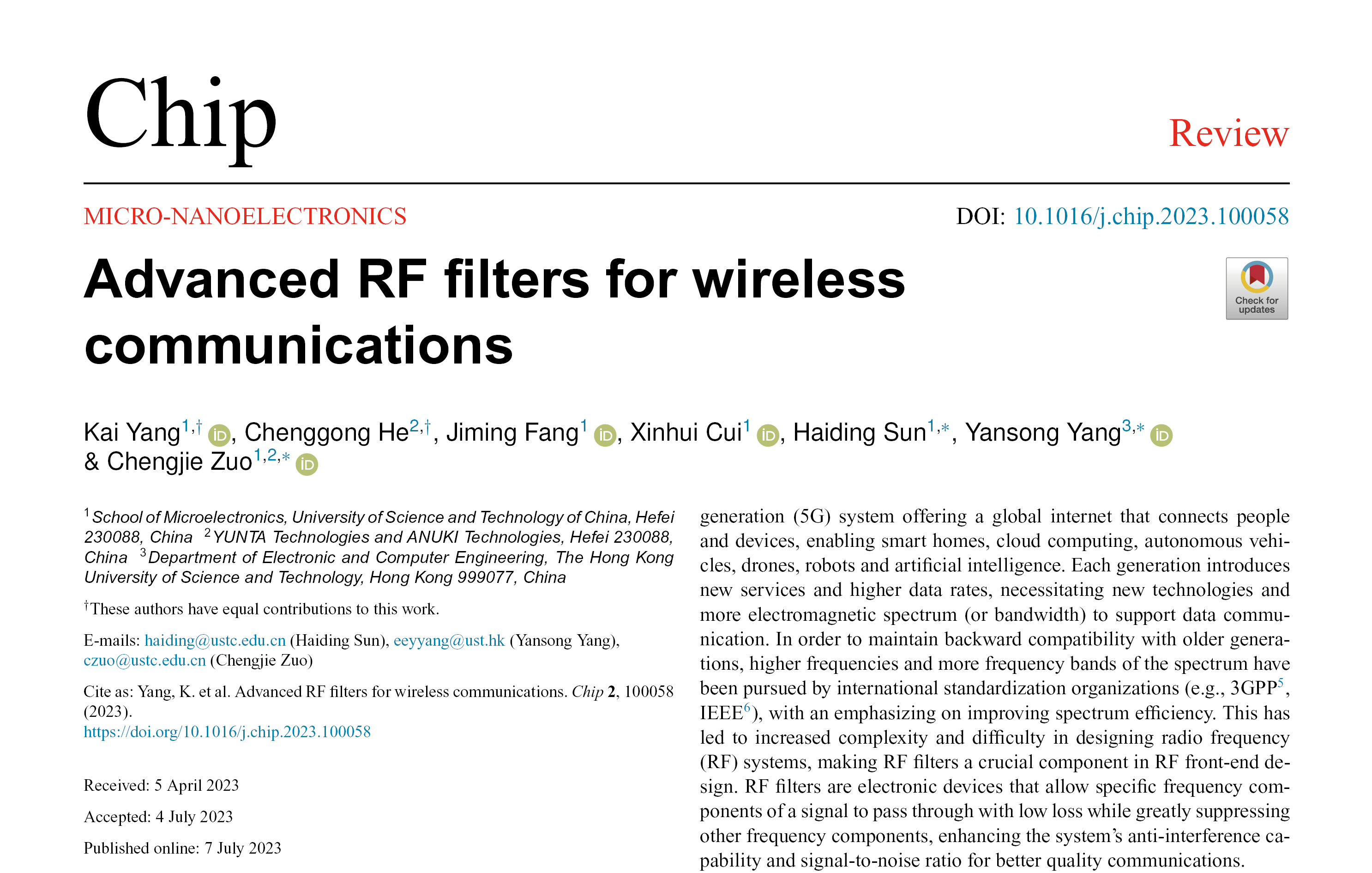
无线通信已成为我们生活的重要组成部分,并彻底改变了我们的生活和工作方式,使人们随时随地都可以相互沟通交流。无线通信技术随着时代发展快速向前演进:第一代(1G)通信系统仅支持低质量的语音通话,而第五代(5G)通信系统则演变成为一个全球性的互联网络(图1),不仅支持人与人的连接,而且支持物与物的万物互联,使得智能家居、云计算、自动驾驶、无人机、机器人和人工智能等成为可能。每一代无线通信系统都会引入新的服务和更高的数据速率,这就需要与之对应的新技术和更多的电磁波频谱(带宽)来支持数据通信。为了保持与前几代网络基础设施的反向兼容,国际标准化组织(比如3GPP²、IEEE)通常会在新标准中使用更高频率的频谱,并定义更多的标准频带,一直以来的优化重点都在于提升频谱使用效率。这些变化导致射频(RF)系统设计的复杂度和难度都大大增加,使得射频滤波器成为射频前端设计中最为关键的组件。
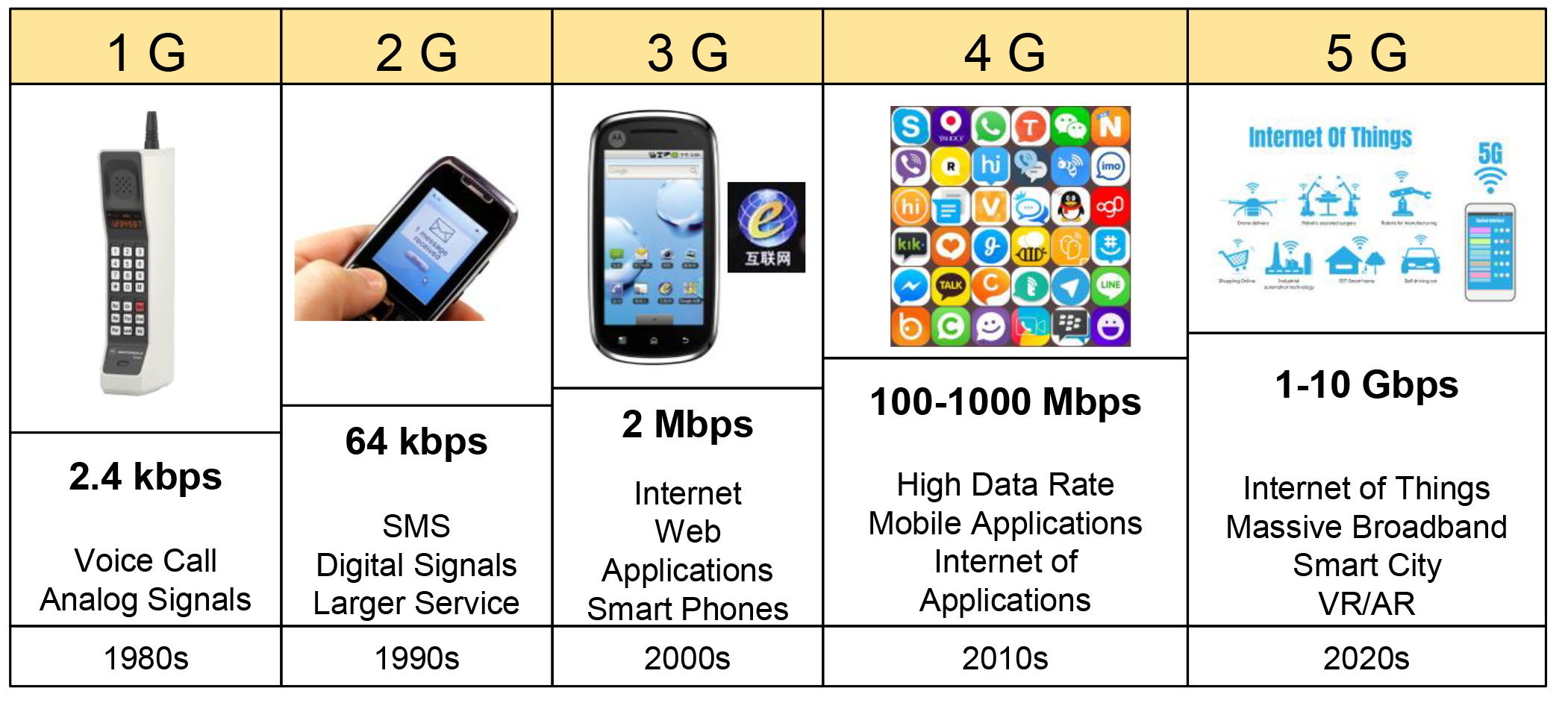 图1 | 1G到5G无线通信技术的发展历程。
图1 | 1G到5G无线通信技术的发展历程。射频滤波器是一种基础电子元器件,可以让电磁波信号中特定频率的成分低损耗通过,同时极大地抑制其他频率成分,增强系统的抗干扰能力和信噪比,从而获得更好的通信质量³。大多数滤波器技术都是基于谐振元件,比如电磁谐振器或者声波谐振器。声波谐振器的优点在于,在相同的工作频率下,它们的波长通常比电磁波小几个数量级,从而可以实现面积小于1平方毫米的微型化芯片级声波滤波器。当前智能终端中主流使用的射频滤波器技术包括声表面波(SAW)、体声波(BAW)、低温共烧陶瓷(LTCC)、集成无源器件(IPD)等,如图2。此外,一些新兴的滤波器技术,比如IHP-SAW(薄膜SAW)、悬浮薄膜铌酸锂(LiNbO₃或LN)谐振器、混合(Hybrid)技术等,也成为了研究的热点。
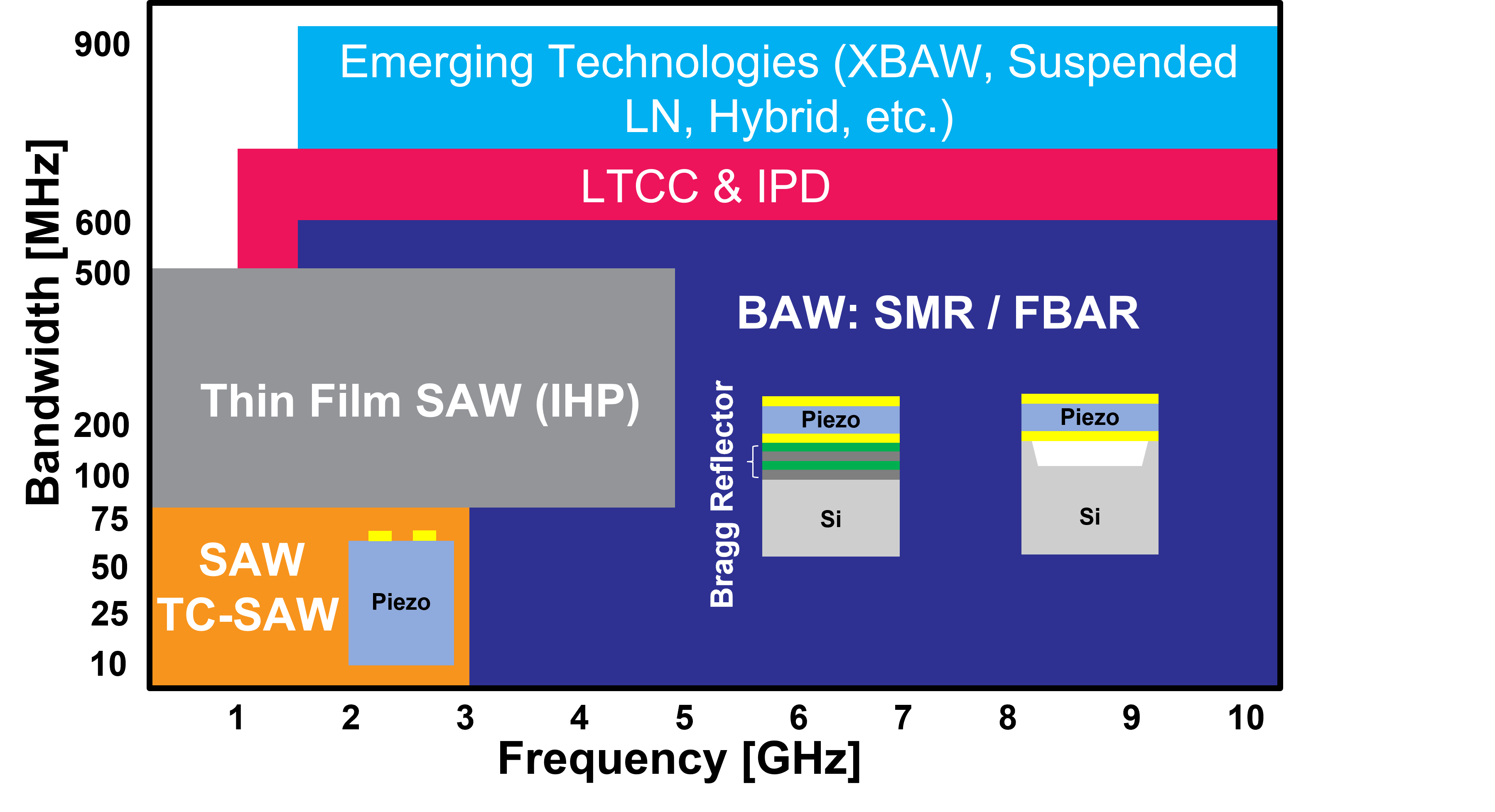 图2 | 用于不同频段的射频滤波器技术。
图2 | 用于不同频段的射频滤波器技术。这篇综述第一次根据不同滤波器技术在历史上被引入的时间线进行组织,并结合每一代无线通信标准(1G至5G)的特点,充分地阐述每个滤波器技术在当时的系统背景下被发明的必要性、工作原理、典型应用、未来趋势等,让读者在了解有什么的同时,更深刻地理解为什么。
首先,作者介绍了在2G和3G时代的滤波器技术。由于具有成本低、体积小、重量轻、可靠性高等优点,基于SAW的射频滤波器被广泛应用于2G和3G移动通信系统⁴,尤其在1 GHz以内的频率范围,SAW几乎成了唯一的选择。在文章中,作者系统地描述了SAW滤波器技术的相关理论、发展历程及典型应用。
其次,在4G时代,作者重点介绍了TC-SAW(温度补偿SAW)和BAW器件。相比SAW器件而言,BAW具有更高的工作频率、高品质因数(Q值)和出色的功率耐受能力⁵。文章讲述了在2 GHz频段非常拥挤的背景下,温度补偿和高Q值对于系统应用的必要性,从而催生了TC-SAW和BAW的出现。此外,作者还在文章中总结了常用于描述谐振器电学特性的Mason、MBVD等等效电路模型。
与3G/4G频带相比,5G NR频带(n77、n78、n79)的带宽明显更大(10倍提升),传统的声波滤波器无法覆盖如此大的带宽(> 500 MHz),因此基于电磁原理的电感和电容(LC)滤波器成为5G部署初期的主流解决方案。作者在文章中介绍了低温共烧陶瓷(LTCC)和集成无源器件(IPD)这两种目前在5G终端中广泛应用的宽带滤波器技术,但LC滤波器无法提供陡峭的滚降,不能对相近的邻带提供很好的抑制⁶。
最后,文章重点讨论了薄膜SAW、悬浮薄膜铌酸锂谐振器、单晶体声波谐振器(XBAW)、混合(Hybrid)滤波器等新兴的滤波器技术(如图3),及其在Q值、频率、带宽等方面的突破。更高的性能、更小的尺寸、更低的成本一直以来是无线通信产业孜孜不倦的追求,作者相信新型薄膜材料和制造工艺的基础性突破对于射频滤波器的未来发展是必不可少的。曾几何时,研究者们认为声波滤波器技术无法工作到10 GHz以上,但毫米波(mmWave)频段声波谐振器的实现已经打破了这一成见。创新不会戛然而止,因为无线通信将继续向6G、卫星互联网等更多意想不到的方向演进。
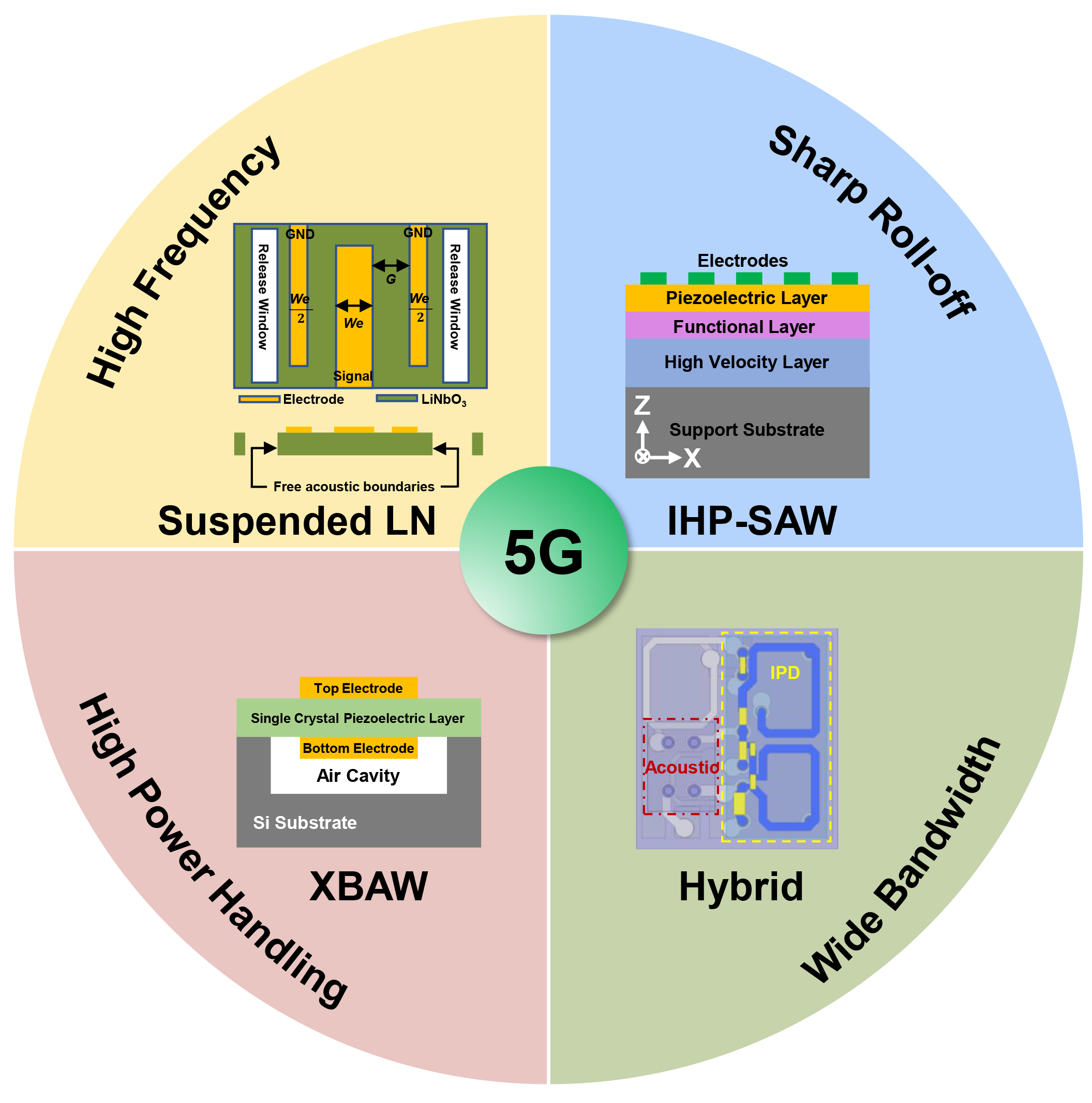 图3 | 用于5G及下一代无线通信的新兴滤波器技术。
图3 | 用于5G及下一代无线通信的新兴滤波器技术。Advanced RF filters for wireless communications¹
Wireless communication has become an essential part of our lives and has revolutionized the way we live and work. It allows us to communicate with each other regardless of time and distance. Wireless communication has evolved significantly, with the first generation (1G) system providing only low-quality voice calls and the fifth generation (5G) system offering a global internet that connects people and devices (Fig. 1), enabling smart homes, cloud computing, autonomous vehicles, drones, robots and artificial intelligence. Each generation introduces new services and higher data rates, necessitating new technologies and more electromagnetic spectrum (or bandwidth) to support data communication. To maintain backward compatibility with older generations, international standardization organizations (e.g., 3GPP², IEEE) have pursued higher frequencies and more frequency bands of the spectrum, emphasizing on improved spectrum efficiency. This has led to increased complexity and difficulty in designing radio frequency (RF) systems, making RF filters a crucial component in RF front-end design.
RF filters are electronic devices that allow specific frequency components of a signal to pass through with low loss while greatly suppressing other frequency components, enhancing the system's anti-interference capability and signal-to-noise ratio for better quality communications³. The advantage of acoustic resonators is that their wavelength (μm level at GHz) is several orders of magnitude smaller than the electromagnetic wavelength (cm level at GHz in air) for the same operating frequency, allowing for miniaturization of acoustic filters into small chips with an area of less than 1 mm². Mainstream RF filter technologies include surface acoustic wave (SAW), bulk acoustic wave (BAW), low temperature co-fired ceramic (LTCC) and integrated passive device (IPD), etc., as shown in Fig.2. Some emerging filter technologies, e.g., IHP-SAW (TF-SAW), suspended thin-film lithium niobate (LiNbO₃ or LN) resonant devices and Hybrid, have also become research hotspots.
This review paper is organized according to the timeline when different filter technologies were introduced alongside each generation of wireless communication standard (1G to 5G).
First, the authors introduce the dominant filter technology adopted in the 2G and 3G era. Due to the advantages of low cost, small size, light weight and high reliability, SAW RF filters are widely used in 2G and 3G mobile communication systems⁴. Especially for the frequency range below 1 GHz, SAW is almost exclusively used for filtering. In the paper, the authors systematically describe the relevant theories, development history and typical applications of SAW filters.
Secondly, for the 4G era, the authors transition to TC-SAW and BAW devices. Compared with SAW, BAW devices have higher operating frequency, higher quality factor (Q) and excellent power durability⁵. In the background of many 4G bands crowded in the 2 GHz range, temperature compensation and high Q became a necessity in system applications, which facilitated the invention of TC-SAW and BAW. In addition, the authors also summarize the Mason and MBVD equivalent circuit models that are commonly used to describe the electrical behavior of acoustic resonators.
Compared with 3G/4G frequency bands, the bandwidth of 5G NR frequency bands (n77, n78 and n79) is significantly larger (10 times), and traditional acoustic filters (SAW or BAW) cannot cover such a wide bandwidth (> 500 MHz). Therefore electromagnetic filters based on inductors and capacitors (LC) became the solution in the early stage of 5G deployment. In the paper, the authors review the low temperature co-fired ceramic (LTCC) and integrated passive device (IPD) technologies, which are the two dominant wideband filter technologies used in today's 5G handsets. While LC filters can form wide passband, they cannot provide sharp roll-off or high rejection on the close-in neighboring bands⁶.
Finally, the paper puts emphasis on several emerging filter technologies (Fig. 3), such as IHP-SAW (thin-film SAW), suspended thin-film lithium niobate resonant devices, XBAW and Hybrid, which show great promise for achieving high quality factor, high frequency and wide bandwidth. Higher performance, smaller form factor and lower cost are the three objectives that have long been pursued by the wireless communication industry. The authors believe that fundamental breakthroughs in thin-film materials and fabrication techniques are necessary for the future development of RF filters. Once upon a time, it was believed that acoustic devices could only work up to 10 GHz, which has been proven wrong by the demonstration of acoustic resonators at mmWave frequencies. Innovations will not cease, as wireless communication will continue to evolve towards 6G, satellite internet and beyond.
参考文献:
1. Yang, K. et al. Advanced RF filters for wireless communications. Chip 2, 100058 (2023).
2. The 3rd Generation Partnership Project. 3GPP. Accessed March 20, 2023.
3. Lakin, K. M. A review of thin-film resonator technology. IEEE Microwave Mag. 4, 61-67 (2003).
4. Ruppel, C. C. W. Acoustic wave filter technology–a review. IEEE Trans. Ultrason. Ferroelectr. Freq. Control 64, 1390-1400 (2017).
5. Lakin, K. M., et al. Development of miniature filters for wireless applications. IEEE Trans. Microwave Theory Tech. 43, 2933-2939 (1995).
6. Zuo, C., et al. Hybrid filter design for 5G using IPD and acoustic technologies. In 2019 IEEE International Ultrasonics Symposium (IUS), 269-272 (IEEE, 2019).
文章链接:
https://www.sciencedirect.com/science/article/pii/S2709472323000217
作者介绍
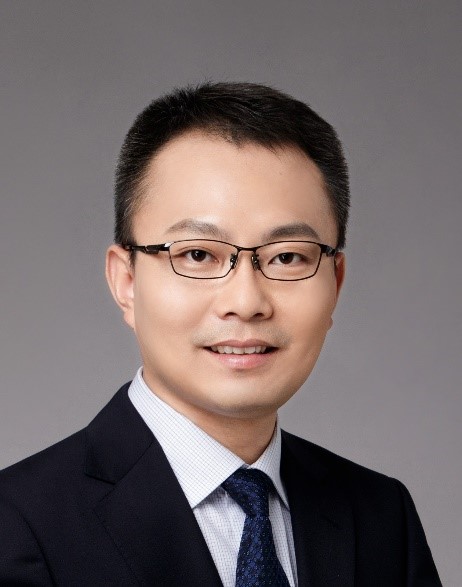
左成杰,中国科学技术大学微电子学院教授、安徽云塔电子科技有限公司创始人。本科毕业于中国科学技术大学,硕士毕业于荷兰代尔夫特理工大学(荣誉毕业生),博士毕业于美国宾夕法尼亚大学。曾任职美国高通公司,期间在声波滤波器方面取得突破,发明了「截面模态谐振器」,因此获得「高通技术论坛」第一名。研究与工作期间,发表国际论文40余篇;美国专利申请超过140项,其中97项已获授权;另外还申请中国发明专利超过110项。曾获得IEEE高级会员、IEEE固态电路学会博士成就奖、安徽省战略性新兴产业技术领军人才、安徽省高层次科技人才团队、安徽省教学成果奖一等奖、合肥市庐州英才等荣誉。
Dr. Chengjie Zuo is a professor in the School of Microelectronics at the University of Science and Technology of China (USTC) and the founder of YUNTA Technologies. Dr. Zuo received the B.S. degree in electronic information science and technology from the University of Science and Technology of China (USTC), the M.Sc. degree (with honors) in electrical engineering from Delft University of Technology (TU Delft), and the Ph.D. degree in electrical and systems engineering from the University of Pennsylvania (Penn). Dr. Zuo is an IEEE senior member and a recipient of multiple awards including the IEEE Solid-State Circuits Society Predoctoral Fellowship. Dr. Zuo has published more than 40 papers, 140 US patent applications (among which 97 patents have been granted), and 110 Chinese patent applications.

杨凯,目前在中国科学技术大学攻读博士学位,研究方向主要为射频MEMS谐振器,传感器和振荡器。
Yang Kai is a PhD student in University of Science and Technology of China (USTC). He is working on piezoelectric RF-MEMS resonators, sensors, and oscillators.
关于Chip
Chip(ISSN:2772-2724,CN:31-2189/O4)是全球唯一聚焦芯片类研究的综合性国际期刊,已入选由中国科协、教育部、科技部、中科院等单位联合实施的「中国科技期刊卓越行动计划高起点新刊项目」,为科技部鼓励发表「三类高质量论文」期刊之一。
Chip期刊由上海交通大学出版,联合Elsevier集团全球发行,并与多家国内外知名学术组织展开合作,为学术会议提供高质量交流平台。
Chip秉承创刊理念: All About Chip,聚焦芯片,兼容并包,旨在发表与芯片相关的各科研领域尖端突破性成果,助力未来芯片科技发展。迄今为止,Chip已在其编委会汇集了来自14个国家的70名世界知名专家学者,其中包括多名中外院士及IEEE、ACM、Optica等知名国际学会终身会士(Fellow)。
Chip第二卷第四期将于2023年12月在爱思维尔Chip官网以金色开放获取形式(Gold Open Access)发布,欢迎访问阅读本期最新文章。
爱思唯尔Chip官网:
https://www.sciencedirect.com/journal/chip




